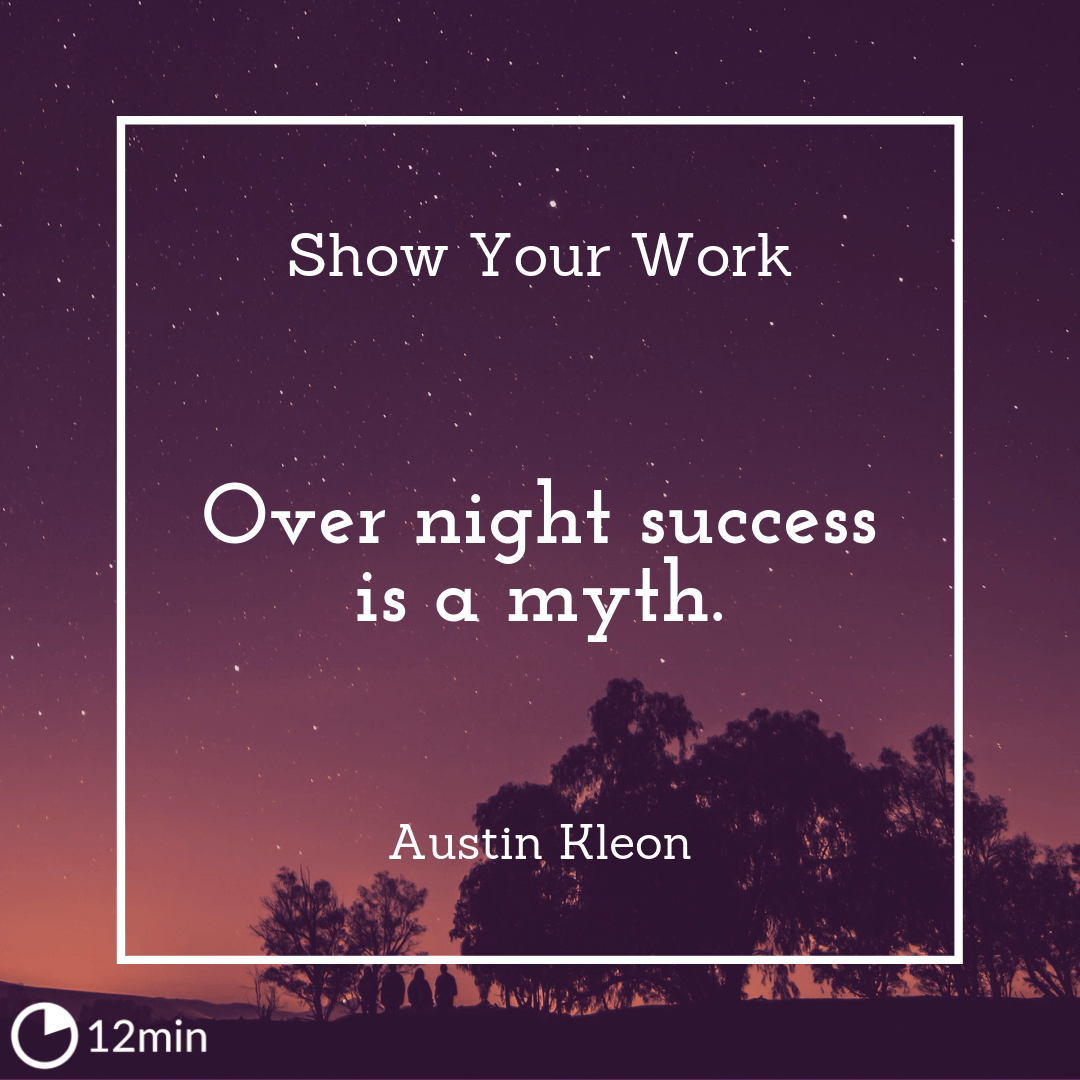Show Your Work Summary
7 min read ⌚
10 Ways to Share Your Creativity and Get Discovered
Is it a sign of lack of modesty to believe too much in your work? Or calling yourself an artist? This is not a teasing. The answer is very simple: NO.
But is the modesty a disease that creates a wall between artists and the world who’s expecting their work?
Maybe.YES/NO/I have no idea. Which one will be your answer?
Austin Kleon teaches us 10 valuable lessons about overcoming those unproductive forms of modesty that lead us directly on becoming nobody.
If your answer is YES, you should definitely consider reading ‘Show Your Work! 10 Ways to Share Your Creativity and Get Discovered’ from the author of The New York Times Bestseller Austin Kleon.
REVEAL YOUR STRENGTHS / SHOW YOUR WORK!
You have to remember that your work is something you do, not who you are.
“Show Your Work Summary”
Even if your profession does not revolve around art, I still consider you should check out this book. Most probably it will show you a totally new perspective on your own life and the way you approach the professional side of it.
I was tremendously blessed to get in contact with this book at just the right moment of my life.
With an education in graphic design and with the stubbornness of earning my own living out of my art, Austin Kleon’s book had an impressive motivational effect upon me.
The deep and extremely useful message of this book is empowered by the author’s personal vast and relevant experience. This personal experience of Austin Kleon easily turns into the key concept of his book ‘Show Your Work!’.
It is about a 10 steps guideline containing all the necessary knowledge in order to transform an artist’s career ‘from zero to hero’.
This book is the indispensable asset that each aspiring artist must possess if he aims to reinvent himself and to make his work noticeable.
But who is Austin Kleon? An American writer and artist living in Austin, Texas, bestselling author of three illustrated books:
‘Newspaper Blackout’
‘Show Your Work!’
Beyond all those covers he described himself as “a writer who draws” who makes “art with words and books with pictures”.
The title of Austin Kleon’s latest book is suggestive enough and even over-descriptive for the actual content of the book. Consequently, the author shares with his readers 10 efficient ways to make their work visible to others and to get discovered in order to pursue their professional career in art.
By this “10 steps master plan” Austin Kleon ingeniously intends to offer a helping hand to all the aspiring artists on the market.

The first lesson that Austin Kleon kindly teaches us is that ‘You Don’t Have to Be a Genius’ in order to achieve self-contentment regarding your career as an artist.
Sometimes, being an amateur proves to be much more helpful than being an expert. That’s because amateurs have that rare quality of approaching every new situation with freshness and innocence. And in the end, this kind of approach always leads to spectacular results!
Austin Kleon destroys the ‘lone genius’ myth that most of us are accustomed with by simply putting things straight:
Good work isn’t created in a vacuum.
Hence, he invites us to step out our comfort zones and to start creating connections with other people and expose ourselves to other people. Within this context, the author emphasizes the great importance of sharing information when you pursue an artistic profession:
Share what you love, and the people who love the same things will find you.
The second step of ‘Sharing Our Creativity and Getting Discovered’ plan refers to ‘Thinking Process, Not Product’.
As most of us are used to relate to our creative work in terms of final products, Austin Kleon invites us to reconsider this perspective upon work.
How? By stating the tremendous significance of the process that leads to the ultimate product: ‘You have to turn the invisible into something other people can see.’
Another major lesson I’ve learned from this book is contained within the third step of the ‘Show Your Work’ process and it’s about ‘Sharing Something Small Every Day.’
Austin Kleon’s firm statement may seem quite shocking at first: ‘Online, you can become the person you really want to be’.
Despite this first impression, Austin unravels a deep truth about every artist’s aspiring career: ‘in this day and age, if your work isn’t online, it doesn’t exist.’
Lesson learnt: every artist should adapt to this new communication era and start exploring the multiple opportunities of the virtual universe. So, for an artist to be online and to be engaged in sharing information about his work it’s a must!
Online generosity is among the best attitudes that an artist can adopt both at the beginning of his career and along with his ongoing career.
Even though sharing is extremely important, the author warns us in a pretty ironic way that the content of the things we choose to share online also matters: ‘Don’t show your lunch or your latte; show your work.’
As the fourth step of our ‘Getting Discovered’ process, Austin Kleon makes an invitation for us to ‘Open up Our Cabinet of Curiosities.’
This metaphoric idea of a ‘Cabinet of Curiosities’ simply refers to all the things we like or dislike in our daily life. The author says that our tastes and our influences indirectly reveal who we actually are and have the power to ‘cast a shadow over our own work.’
We have to learn to own our tastes and to share them with other people because ‘being open and honest about what you like is the best way to connect with people who like those things, too.’
Even if it may not be the first thought that comes to mind when we think about a career in art, though, ‘Telling Good Stories’ is something that each artist should get better at. This is the no. 5 lesson of the ‘Show Your Work’ book.
Austin Kleon asserts that ‘Words matter’ because, to our dissatisfaction, ‘Our work doesn’t speak for itself.’ Consequently, artists must learn to become better storytellers if they want to achieve success with respect to their careers.
Each work of art has a story behind it and this story is exactly what the artist must bring in front of its audience.
A good story will always sell the product it ‘packages’!
Within the sixth step of our transformation process, Austin Kleon introduces the idea of being generous with our own knowledge about our work and sharing it with the people interested in it.
The main reason he advises us to shift our attention towards this behavior is because, when you teach someone how to do your work, you are, in effect, generating more interest in your work.
Generosity is always a proof of empathy. And empathy always nourishes loyalty.
We must always keep in mind that ‘If you want to get, you have to give.’
No matter how tempting the virtual universe may appear to the artists, one should constantly be aware of not ‘Turning Into a Human Spam’. In this seventh step, Austin Kleon teaches us that there is a fine line between sharing and over-sharing information online. So, we must always recall not to cross this line if we want to avoid rejection from our desired public.
When the artists decide to expose their work in front of the world, they ‘have to be ready for the good, the bad, and the ugly’. And also they have to learn how to accept any criticism that may come their way.
In the eighth chapter, ‘Learn to Take a Punch’ you’ll find out how artists can deal with the criticism that is inherent to their profession. Related to the matter of criticism, we must become conscious of one basic rule: ‘You can’t control what sort of criticism you receive, but you can control how you react to it.’
We have to be willing to accept and expose our own vulnerability if we want to establish authentic connections with other people.
Within the ninth step, suggestively entitled ‘Sell Out’, the author brings into discussion the financial aspect of the artistic career.
Even though art is something usually referred to as being born out of the artist’s own intimate pleasure and with no intended financial purpose, artists still have to earn their living.
Every artist must learn how to correctly evaluate his work and how to accurately charge for it.
Out of the tenth, the last chapter, ‘Stick Around’, contains the most strongly motivational message.
Whether we experience a success or a failure in our professional career, what matters the most is ‘not to quit prematurely.’

We shall never think of our career as starting over.
We must always think of it as beginning again!
After covering the entire content of the book ‘Show Your Work’, the artist will most probably become able to actually and properly ‘show his work’ to the world.
The most important aspect is that the reader will learn how to deal with and to overcome the entire struggle that comes with starting a career in art.
Like this summary? We’d Like to invite you to download our free 12 min app, for more amazing summaries and audiobooks.
“Show Your Work Quotes”
Don't think of your website as a self-promotion machine, think of it as a self-invention machine Share on X Amateurs are not afraid to make mistakes or look ridiculous in public. They're in love, so they don't hesitate to do work that others think of as silly or just plain stupid. Share on X The best way to get started on the path to sharing your work is to think about what you want to learn, and make a commitment to learning in front of others. Share on X Don't talk to people you don't want to talk to, and don't talk about stuff you don't want to talk about. Share on X Don't feel guilty about the pleasures you take in the things you enjoy. Share on XOur Critical Review
So, being an artist is no longer about solitude. It’s more about opening the door of your workroom through the online world and let them see the story behind the man, the artist and his art.
For each good story there are always great listeners ready to show their appreciations. So, show up & show your work!
Emir is the Head of Marketing at 12min. In his spare time, he loves to meditate and play soccer.







